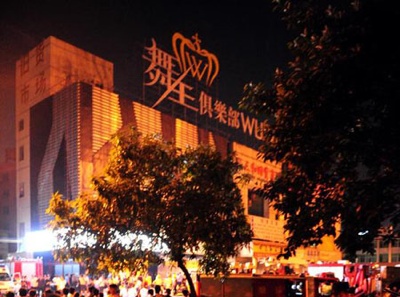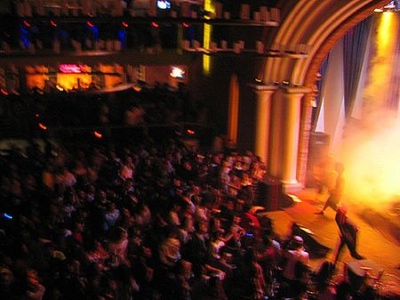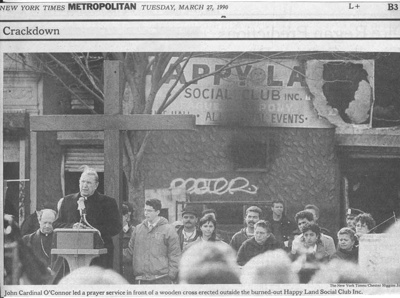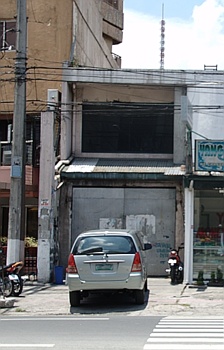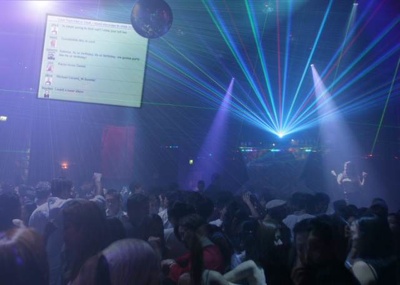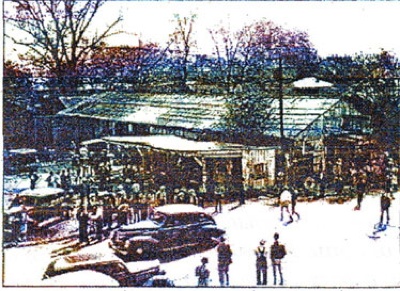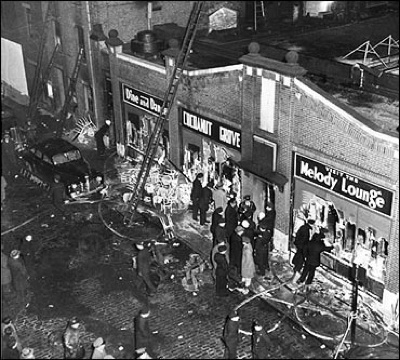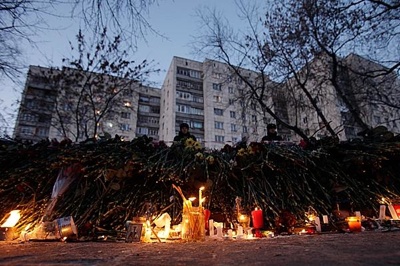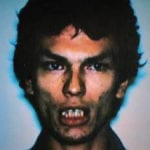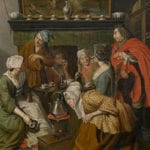 Weird Stuff
Weird Stuff  Weird Stuff
Weird Stuff  Crime
Crime The 10 Most Infamous Gangs in History
 Miscellaneous
Miscellaneous Ten Groundbreaking Tattoos with Fascinating Backstories
 Our World
Our World 10 Green Practices That Actually Make a Difference
 Humans
Humans Ten Historic Men Who Deserve Way More Credit Than They Got
 Movies and TV
Movies and TV The 10 Most Heartwarming Moments in Pixar Films
 Travel
Travel Top 10 Religious Architectural Marvels
 Creepy
Creepy 10 Haunted Places in Alabama
 History
History Top 10 Tragic Facts about England’s 9 Days Queen
 Food
Food 10 Weird Foods Inspired by Your Favorite Movies
 Weird Stuff
Weird Stuff The 10 Weirdest Materials That Can Be Used to Make Paper
 Crime
Crime The 10 Most Infamous Gangs in History
 Miscellaneous
Miscellaneous Ten Groundbreaking Tattoos with Fascinating Backstories
Who's Behind Listverse?

Jamie Frater
Head Editor
Jamie founded Listverse due to an insatiable desire to share fascinating, obscure, and bizarre facts. He has been a guest speaker on numerous national radio and television stations and is a five time published author.
More About Us Our World
Our World 10 Green Practices That Actually Make a Difference
 Humans
Humans Ten Historic Men Who Deserve Way More Credit Than They Got
 Movies and TV
Movies and TV The 10 Most Heartwarming Moments in Pixar Films
 Travel
Travel Top 10 Religious Architectural Marvels
 Creepy
Creepy 10 Haunted Places in Alabama
 History
History Top 10 Tragic Facts about England’s 9 Days Queen
 Food
Food 10 Weird Foods Inspired by Your Favorite Movies
Top 10 Modern Night Club Fires
Nightclubs, a place for fun, dance, drink, and celebration, can quickly turn into deadly fire traps, killing hundreds of guests, entertainers, and staff. Here are ten of the deadliest nightclub fire disasters from 1940-2009. Though almost 60 years separates the oldest from the most recent, common threads run through all of these nightclub fires, overcrowding, locked exits, flammable decorative and construction materials, making them, in most cases, preventable catastrophes. The use of pyrotechnic displays or fireworks inside the buildings, usually as part of live stage acts or bands, has been the cause of many of these fire disasters, and the two most recent that occurred in 2009.
Just before midnight on September 21, 2008 the Wuwang Club located in Shenzhen, People’s Republic of China caught fire. 43 people were killed and another 88 were injured. As we will see over and over again, the fire was started by careless use of indoor pyrotechnics. The pyrotechnics ignited flammable material on the ceiling. The fire caused the lights to fail, plunging the club into darkness. The combination of fire and darkness caused the people inside the building to panic and rush for the exits. There were few well lit exits and windows had been boarded up, making them useless as an escape route. There were 308 people inside the club when the fire started. Most of the deaths were caused by crushing and suffocation in the rush for the exits. As is the case with so many nightclub fires, the building was not properly built and was unlicensed because of government corruption.
The Santika Pub was known as one of the hottest nightclubs in Thailand, a place for young Thais and others from around the world to dance and have fun. The club had a large dance area, stage, and mezzanines that overlooked the dance floor. On New Years, January 1, 2009, more than a thousand people were packed into the club to usher in the New Year with celebrations and to say goodbye to the Santika Pub which was scheduled to close and relocate. The club had live entertainment that night, a popular local band, ironically and tragically called “Burn”. Shortly after midnight, the band was playing on stage when, as part of the bands act, pyrotechnic displays were set off and sparks shot towards the ceiling. Revelers were videotaping the event and surviving video shows at 12:15 AM, sparks falling from the ceiling onto the dance floor. The video then shows members of Burn, and audience members, looking to the ceiling as the sparks continued to fall, and the ceiling fire grew larger.
At 12:20 AM the fire was reported to local police, but the fire department was not notified until 12:40 AM. Firefighters arrived at the club at 12:48 AM. In the 33 minutes between the time the pyrotechnics were set off, and the arrival of the fire department, fire raced through the building. Hundreds tried to get down to the main entrance from the balconies, only to find the entrance already jammed with people trying to flee the fire from the main floor. The electricity went out and burning pieces of ceiling fell onto those still trapped inside the building. Eventually, a portion of the roof collapsed. The fire killed 66 and injured another 229, making the Santika Pub fire the worst in Thailand history. Later it was determined the fire began when the pyrotechnics ignited sound proofing and insulating materials on the ceiling. In addition, the building was overcrowded, and the main entrance was not large enough to allow for a quick evacuation – most of those who died were found at the entrance, unable to escape.
Unlike most of the nightclub fires we will see on this list, the Happy Land fire was started by an act of arson. However, like so many other nightclubs, the Happy Land building was an unlicensed “social club”, was built with combustible and flammable materials, had previously been closed for fire safety violations, and the fire exits had been blocked to prevent people from entering without paying. The fire started at the “Happy Land” located in New York City, on March 25, 1990. The fire killed 87 people, 68 on the second floor, and the rest on the first floor. Eleven people were killed inside a first floor restroom. Most of the victims were ethnic Hondurans.
The fire was started by an unemployed Cuban refugee named Julio González, who was upset at his former girlfriend (who worked at the club). As a result of the argument, González was ejected by the bouncer. Angry, he came back to the club with gasoline which he spread on the only staircase into the club. He then used matches to ignite the gasoline. The fire quickly spread to the combustible material used in the entry way, and then spread from the entry way into the first floor bar through a door someone had left open. Unlike so many nightclub fires, the Happy land building did have a partial sprinkler system on the second floor, but not all of the sprinkler heads activated and regardless, the sprinkler system was inadequate to contain and control the fire, which started on the first floor.
The Ozone Disco Club was located in Quezon City, Philippines. The fire started shortly after midnight, March 18, 1996 local time. At the time the fire started there were approximately 390 people crammed into a building that was approved for occupancy of 35! At least 162 people died and 95 were injured. The Ozone Disco Club fire is the worst fire in Philippine history. Like most nightclub fires, the victims were predominately young, in this case, high school and college students attending a graduation. The cause of the fire appeared to be related to sparks, possibly a short circuit, from the disc jockey’s booth. Many thought the smoke, the sparks, and then the lights going out, were part of the show. When they realized it was a fire, there was a rush for the exits. Within minutes, flames had engulfed the inside of the club and its mezzanine had collapsed.
Many of the bodies were discovered along the corridor leading to the only exit, piled up waist-high. Quezon City officials were quoted as saying that the club’s emergency exit had been blocked by a new building next door and that there was no proper fire exit. It was also reported that the exit had been locked from the outside by the club’s guards, who had thought that a riot had taken place. Since the fire, there have been reports of ghostly hauntings of the remains of the building, which was never restored, and still stands today.
The Club Cinq-Sept was a nightclub in south-eastern France just outside the small town of Saint-Laurent-du-Pont, Isère On the night of Sunday, November 1, 1970 a fire started at approximately 1:40 AM, apparently by a carelessly discarded match. About 180 patrons remained inside the nightclub at that time. Of those, 146 people would not live. A popular nightclub with the young, most of the victims were under the age of 30 and many of them teenagers. Like so many nightclubs, the Club Cinq-Sept was constructed and decorated with highly flammable and combustible materials such as polyurethane and papier-mâché . The fire began in the upper gallery and quickly spread. About 30 people were able to escape out the main entrance before the fire fell from the gallery above, blocking the way out. Two other exits were not marked and were locked. All six members of the band playing that night (Storm) perished in the fire.
The Beverly Hills Supper Club fire is the third deadliest nightclub fire in U.S. history. It occurred on the night of May 28, 1977, during the Memorial Day weekend. 165 persons died and over 200 were injured as a result of the blaze. Located in Southgate, Kentucky, The Beverly Hills Super Club was a major attraction, drawing headline talent from Las Vegas, Hollywood, and New York. That night’s entertainment was singer and actor John Davidson. The building had been a popular night spot since 1937 and by the time of the fire in 1977, several additions had created a sprawling complex of rooms, corridors, and service areas connected by narrow corridors.
More than 3,000 guests and staff were inside the club on the evening of the fire. The main show was in the Cabaret Room and it was estimated that over 1,300 patrons had been squeezed into the room. Other guests were in several restaurants, bars, private party rooms, and other rooms. Sometime between 8:30 and 9:00 PM, a fire started in the Zebra Room which had hosted a wedding reception. The fire was discovered around 9:00 AM by waitresses. Attempts were made to control the fire with fire extinguishers, but it was too late. The cause of the fire was never completely determined though it is thought that the use of aluminum wiring may have contributed.
At 9:08 PM, busboy Walter Bailey interrupted the show in the Cabaret Room, taking the stage to ask patrons to leave and pointing out the exits to the left and right of the stage. Some of the spectators obeyed and began to leave the Cabaret Room through the exits. Bailey was hailed as one of the heroes of the night, receiving official recognition and a letter from then U.S. President Jimmy Carter. Bailey said later that for years he rejected the title of hero and wondered if he’d done enough.
The fire burst into the Cabaret Room at 9:10 PM, preceded by thick smoke that spread all over the room, quickly engulfing it. Those who had not evacuated quickly panicked; many of them would be found dead piled up near the main entrance. The flames spread so rapidly that a full evacuation of the sprawling, crowded building was not possible.
Firefighters concentrated on the Cabaret Room where it was known that many people were trapped, but at midnight the roof had collapsed, and authorities doubted any more survivors would be found. John Davidson escaped via a door that had recently been constructed near the talent dressing room. His road manager also escaped, but his musical director perished.
The República Cromañón nightclub was located in Buenos Aires, Argentina. On December 30, 2004, a fire started inside the club because of the unsafe use of fireworks/pyrotechnics. The fireworks, as we have seen before, ignited highly flammable construction and decorating materials, in this case, a plastic net hung from the ceiling, and foam material . Elsewhere in the building, flammable teddy bear stuffing was used as a cheap alternative to fiberglass or rock wool. Approximately 3,000 people were inside the club when the fire started and 194 were killed, another 714 were injured. Where there are pyrotechnic displays, there are usually bands and this fire was no exception. This night, the club was being playing by the rock group Callejeros. The club owner and the band’s lead singer had told the patrons not to use flares inside the building, to no avail. As always seems to be the case with nightclub fires, four of the six doors, some of which were fire exits, were chained shut so that “people would not enter without paying”. Most of the victims died from inhaling poisonous gases, smoke and carbon monoxide. The band members escaped with their lives.
The two deadliest nightclub fires in US history are bookended around the start of the second world war. The second deadliest, the Rhythm Night Club fire, happened on April 23, 1940, barely 18 months before Pearl Harbor. The nightclub was located in Natchez, Mississippi and the fire killed 209 African-American party goers, while severely injuring many others.
The fire started sometime around 11:30 p.m. as members of the local Moneywasters Social Club were enjoying the song “Clarinet Lullaby” performed by Walter Barnes and His Royal Creolians orchestra from Chicago. The fire started at the main entrance door of the building and quickly engulfed the structure in flames. Foretelling future nightclub fire disasters, flammable materials contributed to the speed and intensity of the fire, in this case, decorative Spanish moss was draped over the rafters. When burning, the moss generated flammable methane gas which fueled the fire. With windows boarded up to prevent outsiders from viewing or listening to the music, more than 300 people struggled to escape the building. A few managed to escape but most died from smoke inhalation or were crushed in the stampede to escape. Bandleader Barnes and nine members of his band were among the victims. Only three band members survived, one vowing never to play again. The cause of the fire is unknown but thought to be accidental, possibly related to a carelessly discarded match or cigarette.
The worst nightclub fire in US history also happened near the start of the second world war when the Cocoanut Grove nightclub in Boston, Massachusetts caught fire on the night of November 28, 1942. Almost a year after Pearl Harbor, the nightclub was filled with US military service men and their guests and locals when the fire started. 492 people were killed that night and hundreds more were injured. It is also the second-worst single-building fire in American history; only the Iroquois Theater fire in Chicago in 1903 killed more (602). The tragedy shocked the nation and briefly replaced World War II in news headlines. The fire led to a reform of fire codes and safety standards across the country.
The Cocoanut Grove was filled with approximately 1,000 occupants that evening, more than twice its official capacity of 460. Like the Rhythm Nightclub fire only two years earlier, flammable and combustible materials and decorations were used inside the building. The restaurant, bars, and lounges inside were fitted out with flammable paper palm trees, cloth draperies covering the ceiling, flammable furniture, and other flimsy decorations, some of which obscured exit signs.
The fire started at about 10:15 p.m. in the basement of the building when Stanley Tomaszewski, a 16-year-old busboy, was instructed to turn on a light which had been unscrewed from the socket by a young couple wishing to kiss in the dark. As he attempted to tighten the light bulb back into its socket, the bulb fell out in his hand. In the dimly-lit lounge, Tomaszewski, unable to see the socket, lit a match for a moment to illuminate the area, found the socket, blew out the match, and replaced the bulb. Almost immediately, patrons saw something ignite in the canopy of artificial palm fronds draped above the tables.
The fire quickly spread along the fronds of the palm tree, igniting nearby decorations on the walls and ceiling and raced up the stairway to the main level. People’s hair exploded in flames, oxygen was sucked out of the rooms, and a fire ball exploded through the central dance floor. The flames spread to two other adjoining rooms. Within five minutes, the entire nightclub was ablaze.
Many patrons attempted to exit through the main entrance, the same way they had come in, however, the building’s main entrance was a single revolving door, which quickly became jammed and useless as a means of escape as the panicked crowd piled up at the door. So many bodies were piled inside and out that firefighters had to dismantle the revolving door to get inside.
Outside doors had been welded shut to prevent people from leaving without paying their bills. A plate glass window, which could have been smashed for escape, was instead boarded up and unusable as an emergency exit. Other unlocked doors opened inwards, rendering them useless against the crush of people trying to escape. Fire officials later testified that, had the doors swung outwards, at least 300 lives could have been spared.
Perhaps the best known recent nightclub disaster was The Station nightclub fire. The fire at the Station was captured on video and images of the horror which unfolded were seen around the world. Perhaps the other reason this nightclub fire is so well known is because of the band that was playing The Station that night – the very popular, Great White. The fire began at 11:07 PM on Thursday, February 20, 2003. The Station was a rock n roll themed nightclub located in West Warwick, Rhode Island. One hundred people died in the fire, making The Station fire the fourth deadliest nightclub fire in American history, As we have seen time and time again, the fire was caused when pyrotechnic sparks, set off by the Great White tour manager, ignited flammable sound insulation foam in the walls and ceilings around the stage. This created a flash fire that engulfed the club in 5 1/2 minutes. Some 230 people were injured and another 132 escaped.
The video above shows how quickly a fire can spread through a building, trapping those inside. Like so many other fires started by pyrotechnic displays, the club patrons initially thought the fire was part of the show. Even though the ceiling is clearly on fire, people can be seen in the video continuing to celebrate the bands opening song. Twenty seconds into their first song, the band stopped playing and lead singer Jack Russell calmly remarked into the microphone, “Wow…this ain’t good.” In less than a minute, the entire stage was engulfed in flames. Most of the band members escaped through a nearby exit. The fire alarm then went off. People now realize it is a real fire and unfamiliar with the club layout and the location of other exits, naturally move to the most familiar exit, the entrance where they came in. The resulting stampede for this one exit (though other exits were available) blocked the narrow hallway leading to the front entrance. Many people were trapped inside, crushed, suffocated, or killed by the fire, smoke, and toxic gases. Among those killed were Great White’s lead guitarist, Ty Longley. The fire was caught on videotape by cameraman Brian Butler for WPRI-TV of Providence. Butler was at The Station that night doing a segment on nightclub safety in the wake of the E2 nightclub stampede in Chicago that had claimed 21 lives only four days earlier.
The lessons of the Station and Santika Pub fires did not make their way to Perm Russia. On the night of December 5, 2009 a party was being held to celebrate the 8th anniversary of the Lame Horse Night Club. More than 280 people were invited. At approximately 1:00 AM, as the celebration was being videotaped, someone set of a pyrotechnic device. The club had used such firework displays before. This ignited the low ceiling which was made of a plastic covering and dry willow twigs. At first, no one reacted, possibly thinking the fire was part of the celebration. The master of ceremony continues with the entertainment. Soon after, video shows the fire spreading along the ceiling and quickly moving to the walls. The MC announces that people need to evacuate. People begin to leave. Some evacuated out a rear door, but this exit was not illuminated and unknown to many inside the club.
Most of the crowd went to the main entrance to try to escape the burning building. One leaf of the clubs double doors was sealed shut, slowing the evacuation as panicked people pushed toward the door. As people tried to push through the narrow exit, many did not make it and died only feet from safety as people piled up at the doorway. Others broke windows in an attempt to escape. This allowed oxygen to enter the burning building, speeding the fire. At least 153 people died in the blaze, most killed by carbon monoxide gas and smoke. Scores more were critically burned and are still receiving treatment. The Lame Horse Night Club fire is the deadliest in Russia since the fall of the Soviet Union in 1991. The cause of the fire was the pyrotechnic display igniting the highly combustible and flammable ceiling material.
